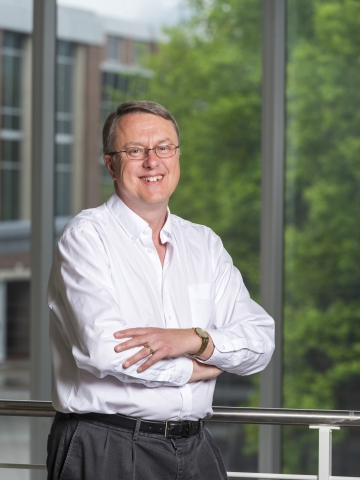Angus Wilkinson
Contact Information
- angus.wilkinson@chemistry.gatech.edu
- Phone
- (404) 894-4036
- Fax
- (404) 894-7452
- Location
- MoSE 1100J
- Research Group
- Angus Wilkinson
- Publication Links
-
Google Scholar
- OrcID
- ResearcherID

Angus Wilkinson
Professor and Associate Chair for Academic Programs
Awards
NSF CAREER award, 1996; Sigma Xi award for outstanding research by a junior faculty member, 1996; Linus Pauling Prize, awarded by the American Crystallographic Association, 1991.
Education
B.A., Chemistry, Oxford University, U.K., 1988; D.Phil., Chemistry, Oxford University, U.K., 1992
Research
Low and Negative Thermal Expansion (NTE) Materials. Most materials expand as they are heated, but there is a growing group of compounds that shrink on heating (display negative thermal expansion). Such materials are of potential use in composites as blending both negative and positive thermal expansion compounds provides a way of tailoring the thermal expansion characteristics of the resulting material. Being able to tailor the thermal expansion characteristics is useful as there are many applications where either zero thermal expansion is desirable (e.g. optical devices where accurate positioning or maintenance of shape is crucial) or there is a need to match the thermal expansion coefficients of two parts that are bonded together. We are currently working on materials from several structural families that have the potential to show either NTE or low TE. This work includes fundamental studies of oxides, oxyfluorides and fluorides. We are particularly interested in the role that structural disorder plays in controling physical properties and the effect of pressure, and more generally stress, on materials performance. Our studies involve synthetic work at Georgia Tech, neutron scattering at the HFIR and SNS facilities, x-ray scattering experiments at the Advanced Photon Source (APS), and collaboration with other groups to measure and understand relevant materials characteristics. Our work on metal fluorides is in part motivated by the opportunity to develop optical materials that are insensitive to temperature fluctuations and are transparent over a wide range of wavelengths into the IR.
New Applications of Synchrotron X-ray Methods. We are actively enagaged in the development of methods and special sample environments for synchrotron X-ray diffraction studies of materials. The extremely high intensity and high-energy X-ray beams that are available from third generation synchrotron sources provide unique opportunities in this arena. In recent years we have developed special sample environments for the examination of thermal expansion while while are under pressure, the in-situ study of cement hydration at the high pressures and temperatures characteristic of deep oil wells, and the simultaneous examination of oil well cement hydration by utrasonic reflection rheometry and x-ray diffraction. We also have along standing interest in the use of resonant , or anomalous, scattering x-ray methods to better understand material's structure.